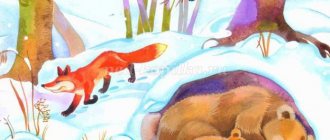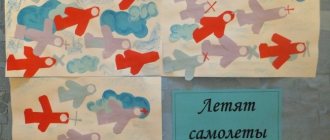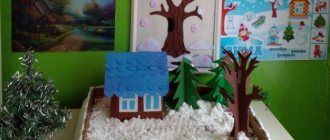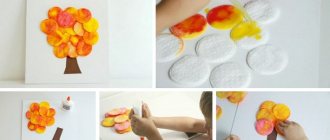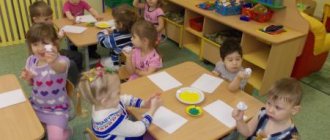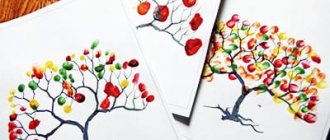Scheme for drawing up lesson notes
The lesson for children lasts 15 minutes. This time is distributed between three stages of mastering the topic:
- introductory stage - up to 3 minutes, aimed at motivating the children;
- the main stage - up to 10 minutes, devoted to a description of the work procedure, demonstration of drawing samples and the drawing process itself, which is preceded by finger exercises and/or physical education;
- the final stage - up to 2 minutes, during which the teacher praises and thanks all the kids for their work.
Table: Cheryapkina L. Summary of a drawing lesson on the topic “Balloons” in the second junior group (fragments)
| Stage | The essence |
| Introductory | The teacher tells the children that he has a gift for them and asks them to guess the riddle: I’m in a hurry for the holiday, I’m holding them by a thread: Red, yellow, blue - They float overhead, There’s nothing better for the kids than the airy ones. — Balloons (helps if children find it difficult to answer, shows a ball)…> |
| <… The teacher invites the children to play with the ball. Physical exercise: Children stand in a circle and hold hands. The adult slowly, melodiously pronounces the words, stepping back: “Inflate my balloon!” “Blow up big...” Everyone stops, holding hands and forming a large circle. The teacher continues: “Stay like that and don’t burst... bang!” - Let's inflate again! - Repeats the words of the game. The ball loves to be thrown up and caught, the ball wants to lie down, the ball can jump (children perform a variety of movements). | |
| Basic | Educator: - Do you like playing with the ball? Let's draw a lot of balls. — Kids love paints and pencils. We will use them to draw What? Can you guess? (ball) - Guys, today we will draw colored balls. You have multi-colored strings drawn on your leaves. Let’s “tie” a red ball to the red thread, a blue ball to the blue thread, a yellow ball to the yellow thread, and a green ball to the green thread. |
| Finger gymnastics | |
| The teacher shows the children how to hold the brush correctly: with three fingers, just above the iron tip, making sure that the children sit straight. First, children perform circular movements in the air, then carefully dip the brush first into water, then into paint. Excess paint is squeezed out on the edge of the jar. The brush is washed from paint and wiped with a napkin. | |
| Final | The teacher puts all the children's drawings on display, analyzes the children's work, praises the children, and, if necessary, helps a child who has difficulty completing a task. |
| Quote from: https://www.maam.ru/detskijsad/konspekt-zanjatija-po-risovaniyu-vo-vtoroi-mladshei-grupe-konspekt-nod-vozdushnye-shary-dlja-detei-2-ml-gr.html | |
Video: drawing lesson on the theme “Chicken” in the second junior group
Drawing on animalistic themes with younger preschoolers opens up new facets of their ideas about the world around them, expands the experience of perceiving the shapes, sizes of objects, as well as shades of colors. Practicing this type of art activity also helps to reveal the creative abilities of little pupils, teaches them to work with different materials for drawing, which is an important stage in the formation of experimental research activities. It also fosters a respectful and caring attitude towards animals and nature in general.
On the topic: methodological developments, presentations and notes
Goal: to form an idea of the family and its members, of the friendly, friendly relationships of relatives. Objectives: Educational: - naming family members, active use of generalizing words.
Goal: to teach how to depict round objects with one movement of the hand.
Summary of continuous educational activities in drawing in the second junior group “Boat”.
Goal: development of children's creative abilities. Objectives: consolidate children's knowledge about the wild animal - the crocodile; form creative thinking, sustainable interest in artistic activities; perfect.
Summary of continuous educational activities in drawing in the second junior group, adapted for carrying out under quarantine conditions. “Apples for bunnies” Prepared by Kireychikova M.Yu.Ts.
Summary of continuous educational activities in drawing in the second junior group, adapted for carrying out under quarantine conditions. “Apples for bunnies.”
Development of productive visual activity: the ability to draw with cotton swabs, using gouache.
Source
On the topic: methodological developments, presentations and notes
Summary of an integrated lesson on visual arts (non-traditional drawing techniques) and music on the topic: “Cockerel”.
Summary of educational activities on visual activities (drawing) for children of the younger group “Rain, more often, drip-drip-drip!” using an unconventional technique of drawing with cotton swabs.
Goals: - to form in children an idea of the characteristic features of the image of a rooster and chickens based on the visual and expressive means of poetic words, music and visual arts.
A bear comes to visit the children and the children introduce him to their city, Zavodoukovsk.
Animals are always very interesting for children. They love to draw them, but it is still difficult for small children to draw animals and the technique of painting with a dry brush “Poke” comes to their aid.
Program content: Teach children to draw in an unconventional way - with a cotton swab; Expand children's understanding of plants and animals in the spring; Develop children's skills in applying stains unconventionally.
Form friendly relations in the team, contribute to the accumulation of experience of friendly relations, a negative attitude towards rudeness. Develop children's spoken language and enrich their vocabulary.
Source
Progress of the lesson:
Educator: Guys, today I suggest you go to a clearing where forest animals . Would you like to go with me?
Educator: Well then, grab your hands and follow me.
Educator: guys, look what this is? It looks like these are someone's tracks , but where are the forest animals ? Guys, maybe you know?
(children's opinions are listened to)
.
Educator: It’s possible that they got scared of us and ran away. Let's find them, and we'll look for them by tracks . First, you need to guess who has what marks ? (I help the children guess who has what marks ,
(we found a squirrel in a tree, a fox in a hole, a bunny behind a bush)
.
Educator: clever guys, we found forest dwellers , now let's invite them to visit us (sit down at the tables)
.
Educator: guys, since we invited a bunny, a squirrel and a fox to visit, let's please them and draw pictures for them. (children draw animal tracks with their fingers )
.
Educator: Well done guys, you tried very hard and the drawings turned out beautiful, I think the forest animals will no longer be afraid of us and will come to visit us more than once (children give their drawings)
.
Educator: Kropotova E. G.
Presentation of a group on non-traditional drawing techniques At the age of ten, at seven, and at five All children love to draw. And everyone will boldly draw everything that interests him. Everything is of interest: Distant.
The influence of non-traditional drawing methods on children's positive emotions. From work experience (abstracts) Theses of accumulation of experience in non-traditional drawing techniques for preschoolers of the teacher of MBDOU kindergarten No. 29 Lena Sagitovna Asfatullina.
Source
Drawing in the second junior group of domestic and wild animals: lesson notes
| Author's full name | Title of the abstract |
| Zinchenko I. | "Fluffy kitten" (painting with a poke) Educational objectives: introduce the technique of poking using a dry brush, teach how to convey the distinctive features of a kitten. Developmental tasks: develop creativity, perseverance, accuracy when working with gouache paints. Educational tasks: to cultivate interest and respect for animals, the ability to notice the beauty of the surrounding world, the desire to help others. Integration of educational areas: “Artistic creativity”, “Cognition”, “Communication”, “Socialization”, “Health”. Demo material: toy cat. Handout: sheets of white paper with an outline image of a kitten according to the number of children, gouache (black, brown, gray and orange), sippy cups, brushes with stiff bristles, coasters for them. Progress of the lesson: A toy cat comes to the group of children. Children look at her, admire her white fluffy fur, and stroke her. The teacher invites the children to turn into little kittens themselves and conducts physical education with them:
The kittens “turn” into children again. The cat turns to them with a request: to draw shaggy fur for her kittens so that they do not feel cold in winter. The teacher informs the kids that they will paint with a hard brush and invites them to pick it up and touch it. The brush should be held vertically, closer to the “skirt”. Children are given the right to choose the color of their kitten - gray, red or black. The teacher demonstrates on the board the process of drawing fur on a finished silhouette of a kitten. Independent activity of children. Exhibition of works. The kitty is very happy (now the kittens won’t freeze in winter) and says “thank you” to the guys. |
| Ivanova E. | “And a zebra has stripes everywhere.” (painting with gouache) Doctor Aibolit comes to the guys and invites them to hot countries. Children guess riddles about African animals:
Then the guys close their eyes, sit on a magic carpet (an ordinary carpet) and “fly” to Africa. Pictures of animals are hung on the board. Physical education “Zebra striped” is being held
Doctor Aibolit points out that the zebra in the picture has no stripes - they were washed away by the magic rain. And only the guys can help the zebra - draw new black stripes for it. The teacher demonstrates techniques for depicting stripes. Independent activity of children. Exit from the fairy tale: preschoolers with Aibolit again sit on the magic carpet and fly into the group. Aibolit says goodbye to them. |
| Marchenko O.I. | "Let's dress up the hedgehog" (drawing with a felt-tip pen) A hedgehog from the forest comes to visit the kids. The teacher talks with the children, asks which of the children saw a live hedgehog and why it needs thorns. Physical education “Hedgehog and Drum” is being held
The teacher invites the children to “dress up the hedgehog” - draw needles on its back using a felt-tip pen. Demonstrates the imaging process. Children draw on their own and then look at each other's drawings. |
| Alekseeva F.Sh. | "Eared Hare" The teacher invites the kids to go skiing into the winter forest. Children imitate the process of putting on skis and go. In the snow (paper that lies on the floor) they notice someone's footprints. With the help of the teacher, the children determine that they belong to a fox, a bunny, a wolf and birds. Children guess the riddle about the hare. A sad bunny appears and whispers in the teacher’s ear that he is bored playing alone. The teacher and children offer to draw him many friends. They discuss what color this animal’s fur coat is in winter and what parts of its body it has. The teacher shows the children the process of drawing a hare with white paint using a hard brush. The image begins with the largest part - the body, then the head, ears, tail, and paws are drawn. Children realize that they are missing eyes, a nose and a mustache - they need to be painted with a regular brush. Physical education “Hares” is being held
Children draw on their own. The bunny is very happy that he has found new friends and says goodbye to the kids. The way out of the fairy-tale situation is for the children to “put on” their skis again and return from the forest to the group. |
